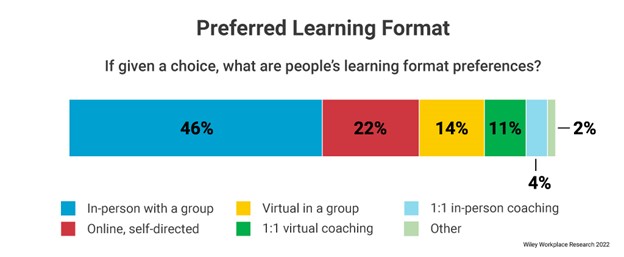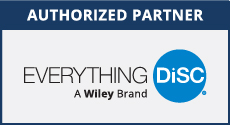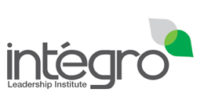By Mark Scullard, Wiley’s Senior Director of Innovation and Research
While the transition to a digitally dependent workplace was initially a rocky one, most organizations have settled into a routine with their work environments, whether it be in-person, hybrid, or virtual. For the most part, people have enjoyed this transition, but there is no doubt that while work/life balance may have improved, individuals are missing the human connection that comes with face-to-face interaction at work – and that loss of connection can affect morale and performance.
What if there is a way to take all that is good about the flexibility of the remote or hybrid workplace and virtual learning and supplement it with live, in-person learning that reconnects colleagues, inspires meaningful aha! moments, and builds trust that paves the way for more cohesion in everyday work life?
Wiley Workplace Research recently surveyed 5,014 people to find out if and how they are engaging in facilitated learning experiences so they can better understand how to help organizations bring people together in a meaningful way.
The Importance of Facilitated Learning
Facilitated learning experiences are a great way to bring people together while building rapport, learning new skills, and delivering solutions that help individuals gain insight into themselves and others. Whether it is a leadership development workshop, team building exercise, or solution aimed at strengthening people skills and increasing emotional intelligence, facilitated learning experiences can harness the power of your people and create momentum that is otherwise difficult to cultivate in the digital or hybrid workplace.
Typically, Facilitators guide a cohort of learners through these experiences. In larger organizations, Facilitators are often learning and development, human resource professionals, or experts in a certain field or subject. In smaller organizations, a convenient option is to bring in a professional Facilitator to customize and facilitate the learning experience for you.
Virtual facilitated learning experiences have served as an incredible opportunity to increase and equalize access to workplace learning and will continue to be a significant, if not primary, way to deliver these experiences. That said, strategically prioritizing in-person opportunities can harness the magic of social learning and real-time connection, infusing a renewed sense of commitment to each employee’s work and colleagues.

Regardless of where people are working, there is a noted need for increased connection among colleagues. While organizations have gone to great lengths to inspire cohesion in virtual workplaces, the truth is that some things are just more powerful when done in person. Often, a one-day in-person training event can inspire deeper connections and increased innovation which will not only impact the individuals involved, but the bottom line as well.

Benefits of In-Person Facilitated Learning
1 It’s a Personalized Experience to Fit the Needs of Your People
From a social and emotional perspective, in-person learning can have a greater impact. However, not everyone retains information in the same way. Taking time to assess your audience and their needs will make the experience more powerful. Facilitators help learners connect the learnings to their roles and responsibilities, so they know how to apply these new skills to real-life scenarios.
When learning with colleagues, everyone can apply the skills and advice from the facilitator in a systematic and coherent way, boosting efficiency and collaboration. 
Most facilitated learning experiences come in two parts; the assessment or prework, and the facilitation which typically involves live, guided activities aimed at increasing knowledge and insight. The personalized reports informed by an individual’s assessment results come to life in these virtual or in-person classroom experiences that engage and educate. These facilitations can be customized to meet the needs of your people and often include easy-to-use facilitation sets that come with tools, scripted content, video, and activities.
2 In-Person Connection Leads to Aha! Moments

The majority of survey respondents stated that interacting with others is the top benefit of in-person learning – not surprising as it is the missing piece in our predominantly digital world. During the learning experience, opportunities are created for colleagues to collaborate, discuss their perspectives, and work on structured activities that are not typical in daily work life. Working together to build trust and cohesion while solving problems and sharing insights is what makes these experiences last much longer than just the day of the event itself.
3 Increased Energy and Impact
It may feel daunting to think that you have to completely revamp your approach to prioritize in-person events. However, the research shows that almost half of respondents preferred to participate in learning experiences in person with a group.

The reality of our digital world is that opportunities to come together as organizations are few and far between – especially with the differences in learning and work preferences. While the interpersonal impact is greatest with in-person learning, the power of live facilitation whether it be in-person or in a live virtual session, provides important points of connection and growth to help your organization thrive. When organizations leverage powerful solutions like Wiley’s own Everything DiSC® and The Five Behaviors® brands, they have the power to create engaged, collaborative, and adaptive cultures that stay connected no matter where they are working.
Learn more about how Laura A. Davis & Associates can help you future-proof your company.











